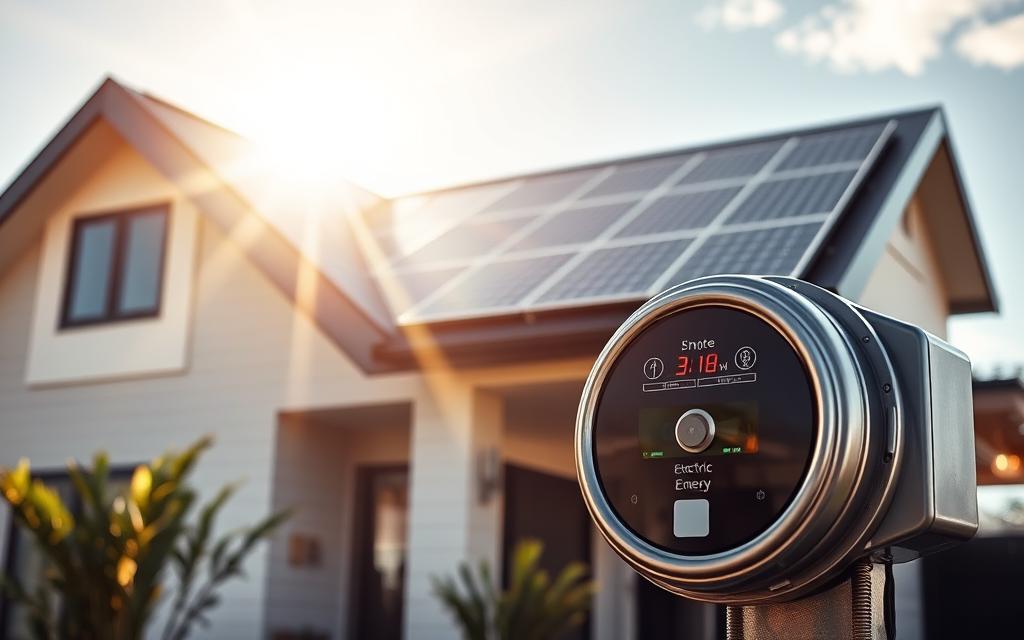Did you know over 3 million homes in the United States now use solar energy? This has led to a big jump in sustainable energy solutions. As more people choose renewable energy, knowing how to integrate solar panels is key.
Solar panel installation can cut down your energy bills. It also helps move towards cleaner energy. This guide will cover the important steps to add solar energy to your home’s electric system. We’ll make sure it’s done smoothly and efficiently.
Understanding Solar Panel Integration
Solar panel integration connects solar panels to your home’s electrical system. This lets homeowners use solar energy efficiently. It makes homes use renewable energy, cutting down on power grid use.
The setup boosts energy production and makes homes more sustainable. It also lowers your monthly energy bills.
What is Solar Panel Integration?
Solar power integration links solar panels to your home’s electric system. It turns sunlight into electricity you can use. This technology helps move towards sustainable energy.
It works well with your home’s current electrical system. This ensures you always have power.
Benefits of Solar Panel Integration
The benefits of solar panel integration are many. Here are some:
- Cost Savings: Lower utility bills because you use less traditional energy.
- Energy Independence: You have more control over your power.
- Environmental Impact: It helps reduce carbon emissions and supports green energy.
- Increased Property Value: Homes with solar systems often have higher market value.
Choosing solar power integration has big benefits. It saves you money and helps the planet. It’s a step towards a greener future for all.
Assessing Your Home’s Energy Needs
To get the most out of solar panels, knowing how much energy your home uses is key. Look at your past utility bills to see how much energy you use each month and year. This helps figure out the right size for your solar system and how much you can save.
Calculating Your Energy Consumption
First, collect at least 12 months of your utility bills. Check the total kilowatt-hour (kWh) usage for each month. This average monthly use shows your total energy demand. Think about how things like the season and changes in your household might affect your energy use.
This careful look ensures your solar panels meet your energy needs perfectly.
Understanding Peak Usage Hours
Knowing when you use the most energy is important for solar system efficiency. These times are usually early morning and late afternoon when you’re using the most appliances. This is when your energy demand is highest, which can lead to higher costs if you’re not using energy wisely.
By improving energy efficiency before installing solar panels, you can use less energy and get more from your solar system.
Types of Solar Energy Systems
Knowing about the different solar energy systems is key for homeowners wanting to go green. Each system has its own perks and fits different energy needs and tastes. Here are three main types of solar energy systems used today.
Grid-Tied Systems
Grid-tied systems link to the local power grid. This lets homeowners use solar energy and still have access to regular power. They can send extra energy back to the grid, lowering their electricity bills. Sometimes, they even get credits for the energy they give back.
Off-Grid Systems
Off-grid systems don’t rely on the grid, perfect for remote areas or those wanting full energy freedom. They use batteries to keep power flowing when the sun isn’t shining. While they cost more upfront, they’re great for avoiding power outages.
Hybrid Systems
Hybrid systems mix grid-tied and off-grid features, offering both flexibility and reliability. They store extra energy for later use and still connect to the grid. This is great for those who want to get the most from their solar setup while keeping energy flowing.
Choosing the Right Solar Panels
Choosing the right solar panels is key for a good solar energy system. It affects how well they work, their cost, and how long they last. Homeowners need to think about a few important things to make the best choice for their solar panel setup.
Factors to Consider
When picking solar panels, consider these key points:
- Efficiency: Panels that are more efficient turn more sunlight into electricity, making more power.
- Durability: Choose panels with long warranties and that last long, to handle the weather well.
- Brand Reputation: Brands known for quality and good service are usually a safe bet.
- Cost: Look at the price of the panels, installation, and any future upkeep costs.
Popular Brands and Models
Many well-known brands lead the solar panel market, known for their quality and new ideas. Here’s a look at some of the top ones:
| Brand | Efficiency | Warranty | Average Cost per Watt |
|---|---|---|---|
| LG | 21.7% | 25 years | $3.00 |
| SunPower | 22.8% | 25 years | $3.50 |
| Canadian Solar | 19.9% | 25 years | $2.50 |
Doing your homework on solar panels helps homeowners get the most out of their system. They’ll save money in the long run.
Understanding Inverters and Their Role
Inverters are key in solar power systems. They change direct current (DC) from solar panels into alternating current (AC). This AC powers home appliances. Knowing about different inverters and their roles helps make solar power more effective at home.
Types of Inverters
There are several types of inverters: string inverters, microinverters, and power optimizers. Each has its own benefits:
| Type of Inverter | Advantages | Best For |
|---|---|---|
| String Inverters | Cost-effective, simple installation | Systems with uniform shading and orientation |
| Microinverters | Optimal performance, individual panel monitoring | Roofs with shading issues or multiple orientations |
| Power Optimizers | Combines benefits of string inverters and microinverters | Systems requiring flexibility and efficiency |
Importance of High-Quality Inverters
Choosing high-quality inverters is crucial for better solar power systems. Good inverters reduce energy loss and improve conversion. This is key for effective solar power use at home. Also, reliable inverters offer better warranties and support, giving homeowners long-term benefits.
Installation Process for Solar Panels
Starting your solar panel journey involves a clear process. You must decide if you want to hire a pro or do it yourself. Knowing what to expect makes the switch to solar energy smoother.
Hiring a Professional vs. DIY
Choosing between a pro and DIY solar setup is tough. Pros ensure your system meets all codes and works best. They check your roof and sunlight, too.
Going DIY can save money and give you a sense of accomplishment. But, it’s crucial to follow safety and efficiency guidelines.
What to Expect During Installation
The installation has several steps. First, experts check the best spot for your panels. Then, they mount them securely and connect everything.
After setup, they test the system to make sure it works right. This thorough process prepares your home for solar power.

| Step | Description |
|---|---|
| Site Assessment | Evaluate the location for solar panel effectiveness, considering sun exposure and roof condition. |
| Mounting Panels | Securely attach panels to the designated structures, ensuring stability and optimal angle for sunlight absorption. |
| Wiring and Connections | Connect the panels to the inverter and electrical system, facilitating energy transfer. |
| Testing | Conduct thorough checks to confirm optimal performance and adherence to safety regulations. |
Integrating with Your Electric System
Connecting solar panels to your home’s electric system is key to getting the most out of solar power. By linking your solar energy system to the grid, you can use excess electricity more efficiently. This setup also lets you earn credits for energy sent back to the grid, which is vital for sustainable energy.
Connection to the Grid
To connect to the grid, you need to get permission from your utility provider. This step makes sure your system meets all the rules. It also lets energy flow between your home and the wider electricity network.
When your solar panels make more energy than you use, that extra goes to the grid. This can lead to financial benefits, making your solar setup more worthwhile.
Setting Up Battery Storage
Battery storage is crucial for better solar power use. It stores extra energy made during sunny hours. This way, you can use power when there’s no sun or during outages.
This setup boosts your energy independence and makes your solar system more effective. Choosing good battery solutions ensures a steady power supply, making your system reliable.
Monitoring and Maintenance
Keeping a solar energy system in top shape is key. Regular checks and monitoring help it work better and last longer. Homeowners can make their renewable energy solutions more effective by staying on top of things.
Importance of Regular Monitoring
Setting up a monitoring system is a smart move. It lets homeowners see how well their solar system is doing. This helps spot any issues with energy output and keeps panels running smoothly.
Regular maintenance can prevent problems caused by dirt, shadows, or other environmental factors. This not only boosts system performance but also saves energy over time.
Tips for Maintenance
Maintaining a solar energy system requires a few important steps:
- Cleaning Panels: Dirt and debris can cut down energy output. Cleaning panels twice a year keeps them efficient.
- Inspection: Regular checks of hardware and wiring can catch wear and tear early.
- Checking Connections: Make sure connections are tight to avoid power loss.
- Monitoring Performance: Use apps or devices connected to the system to track daily, weekly, and monthly performance.
| Maintenance Task | Frequency | Notes |
|---|---|---|
| Cleaning Panels | Every 6 months | Use non-abrasive materials |
| System Inspection | Every 12 months | Check for any signs of damage |
| Performance Monitoring | Continuous | Use smart monitoring solutions |
Financial Incentives for Solar Integration
When it comes to installing solar panels at home, the financial side is key. Many programs offer help, making solar energy more affordable. This includes federal tax credits, state rebates, and local grants.
These incentives help lower the upfront costs. They encourage people to choose renewable energy. This way, they can save money and help the planet.
Tax Credits and Rebates
The federal solar investment tax credit (ITC) is a big help. It lets homeowners deduct a big part of their solar costs from taxes. States also offer rebates to cut down on costs even more.
Local governments add to the savings with grants or incentives. They want to see more energy-saving upgrades. This pushes us toward cleaner energy.
Long-term Savings Considerations
Solar energy saves money in the long run, too. Homeowners pay less for electricity as solar panels produce power. Plus, homes with solar panels often sell for more.
Knowing about these savings is important. It helps make solar panels a smart choice for your home.



